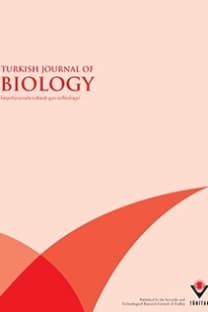In vitro antiproliferative/cytotoxic activity of 2,3'-biindole against various cancer cell lines
2, 3'-Biindole, anticancer, cytotoxicity, apoptosis, antitopoisomerase, C6 cell line, HeLa cell line, HT29 cell line
In vitro antiproliferative/cytotoxic activity of 2,3'-biindole against various cancer cell lines
2, 3'-Biindole, anticancer, cytotoxicity, apoptosis, antitopoisomerase, C6 cell line, HeLa cell line, HT29 cell line,
___
- Ahmed M, Jamil K (2011). Cytotoxicity of neoplastic drugs Gefitinib, Cisplatin, 5-FU, Gemcitabine, and Vinorelbine on human cer- vical cancer cells (HeLa). Biology and Medicine 3: 60–71.
- Ali AQ, Teoha SG, Salhin A, Eltayeb NE, Ahamed MBK, Majid AMSA (2014). Synthesis of isatin thiosemicarbazones deriva- tives: in vitro anti-cancer, DNA binding and cleavage activities. Spectrochim Acta A 125: 440–448.
- Bergman J (1973). Synthesis of 2,3′-biindolyl from indole in one-step reactions. J Heterocycl Chem 10: 121.
- Bergman J, Eklund N (1980). Synthesis of 2,2’-biindolyls by coupling reactions. Tetrahedron 36: 1439–1445.
- Black DSC (1993). New dimensions in indole chemistry: from ligand design to natural products. Synlett 1993: 246–252.
- Bocchi V, Palla V (1982). High yield selective bromination and iodination of indoles in N,N-dimethylformamide. Synthesis 1982: 1096.
- Bocchi V, Palla V (1983). A new procedure for the synthesis of 2-(2-indolyl)pyrroles, 2,3-bi-indolyls, and 2-(3-indolyl)-3-(2- indolyl)indoles. J Chem Soc Chem Commun 1983: 1074.
- Bocchi V, Palla V (1984). Synthesis and spectroscopic characteristics of 2,3,-biindolyl and 2,2-indolylpyrroles. Tetrahedron 40: 3251–3256.
- Chen MF, Chen LT, Boyce HW Jr (1995). 5-Fluorouracil cytotoxicity in human colon HT-29 cells with moderately increased or decreased cellular glutathione level. Anticancer Res 15: 163– 167.
- Chinni SR, Sarkar FH (2002). Experimental therapeutics, preclinical pharmacology akt inactivation is a key event in indole-3- carbinol-induced apoptosis in PC-3 cells. Clin Cancer Res 8: 1228–1236.
- Dupeyre G, Lemoine P, Ainseba N, Michela S, Cachet X (2011). A one-pot synthesis of 7-phenylindolo[3,2-a]carbazoles from indoles and b-nitrostyrenes, via an unprecedented reaction sequence. Org Biomol Chem 9: 7780–7790.
- Ferguson PJ, Collins O, Dean NM, DeMoor J, Li CS, Vincent D, Koropatnick J (1999). Antisense down-regulation of thymidylate synthase to suppress growth and enhance cytotoxicity of 5-FUdR, 5-FU and Tomudex in HeLa cells. Brit J Pharmacol 127: 1777–86.
- Frydoonfar HR, McGrath DR, Spigelman AD (2002). Inhibition of proliferation of a colon cancer cell line by indole-3-carbinol. Colorectal Dis 4: 205–207.
- Frydoonfar HR, McGrath DR, Spigelman AD (2003). The effect of indole-3-carbinol and sulforaphane on a prostate cancer cell line. ANZ J Surg 73: 154–156.
- Gilow HM, Brown CS, Copeland JN, Kelly KE (1991). Sulfenylation of some pyrroles and indoles. J Heterocyclic Chem 28: 1025– 1034.
- Gong J, Traganos F, Darzynkiewicz Z (1994). A selective procedure for DNA extraction from apoptotic cells applicable for gel electrophoresis and flow cytometry. Anal Biochem 218: 314– 319.
- Gribble G (2003). Novel chemistry of indole in the synthesis of heterocycles. Pure Appl Chem 75: 1417–1432.
- Hadden MK, Blagg BSJ (2008). Dimeric approaches to anti-cancer chemotherapeutics. Anti-Cancer Agent Me 7: 807–816.
- Higasio YS, Shoji T (2001). Heterocyclic compounds such as pyrroles, pyridines, pyrollidins, piperdines, indoles, imidazol and pyrazins. Appl Catal A-Gen 221: 197–207.
- Hong C, Firestone GL, Bjeldanes LF (2002). Bcl-2 family-mediated apoptotic effects of 3,3′-diindolylmethane (DIM) in human breast cancer cells. Biochem Pharmacol 63: 1085–1097.
- Howells LM, Gallacher-Horley B, Houghton CE, Manson MM, Hud- son EA (2002). Indole-3-carbinol inhibits protein kinase B/ Akt and induces apoptosis in the human breast tumor cell line MDA MB468 but not in the nontumorigenic hbl100 line. Mol Cancer Ther 1: 1161–1172.
- Ji YY, Zhu YM, Wang JW (2013). GS-2, a pyrazolo[1,5-a]indole de- rivative with inhibitory activity of topoisomerases, exerts its potent cytotoxic activity by ROS generation. Environ Toxicol Phar 36: 1186–1196.
- Joule JA, Mills K (2010). Heterocyclic Chemistry. 5th ed. Oxford, UK: Wiley.
- Katdare M, Osborne MP, Telang NT (1998). Inhibition of aberrant proliferation and induction of apoptosis in pre-neoplastic human mammary epithelial cells by natural phytochemicals. Oncol Rep 5: 311–315.
- ISSN: 1300-0152
- Yayın Aralığı: 6
- Yayıncı: TÜBİTAK
Melis KANT, Bünyamin AKGÜL, Ayten NALBANT
E-microsatellite markers for some naturally occurring Salvia species in the Mediterranean region
Zahra SHAKERAN, Mehrnaz KEYHANFAR, Gholamreza ASGHARI, Mustafa GHANADIAN
Genotoxicity of metaphase-arresting methods in barley
Aslıhan TEMEL, Nermin GÖZÜKIRMIZI
Kanchana NONTHASEN, Weera PIYATHEERAWONG, Pornthap THANONKEO
Evaluation of the genotoxic or mutagenic effects of thermal stress on cultured human lymphocytes
Hasan Basri İLA, Mehmet TOPAKTAŞ, Mehmet ARSLAN, Mehmet BÜYÜKLEYLA, Erman Salih İSTİFLİ
Mehtap DANIŞMAZOĞLU, İsmail DEMİR, Kazım SEZEN, Hacer MURATOĞLU, Remziye NALÇACIOĞLU
Inhibitory effects of salicylic acid on A549 human lung adenocarcinoma cell viability
Djanan VEJSELOVA, Hatice Mehtap KUTLU
Genome-wide distribution of superoxide dismutase (SOD) gene families in Sorghum bicolor
Ertuğrul FİLİZ, Hüseyin TOMBULOĞLU
In vitro antiproliferative/cytotoxic activity of 2,3'-biindole against various cancer cell lines
Tuğba KÖPRÜLÜ KUL, Salih ÖKTEN, Ramazan ERENLER, Şaban TEKİN
